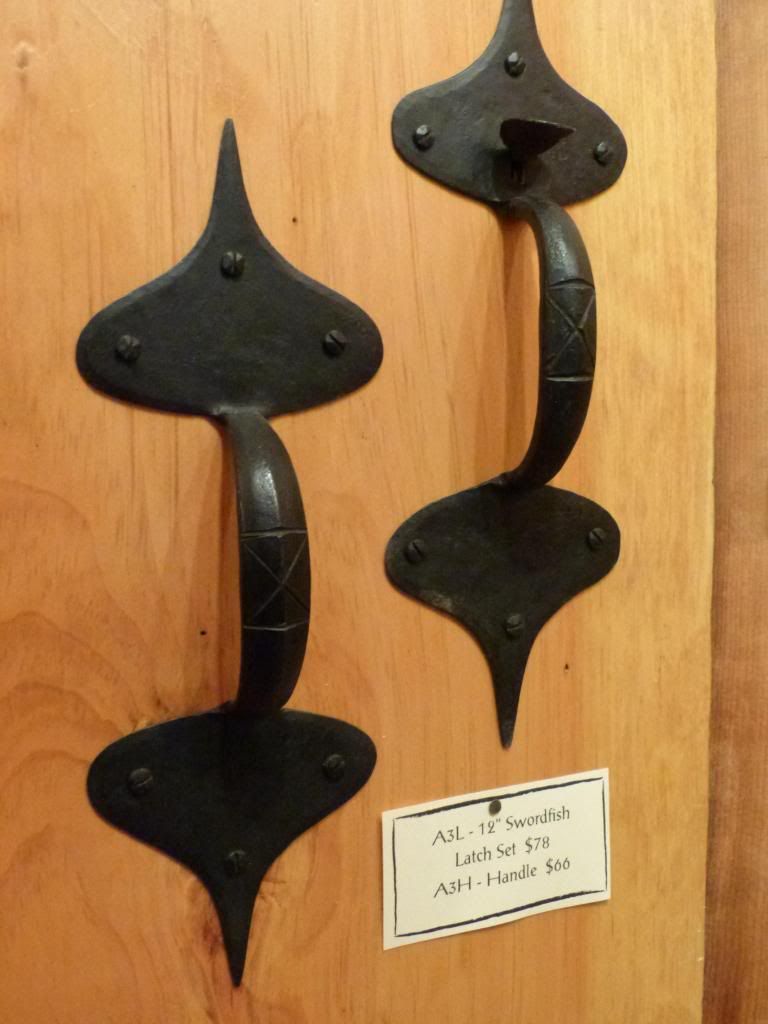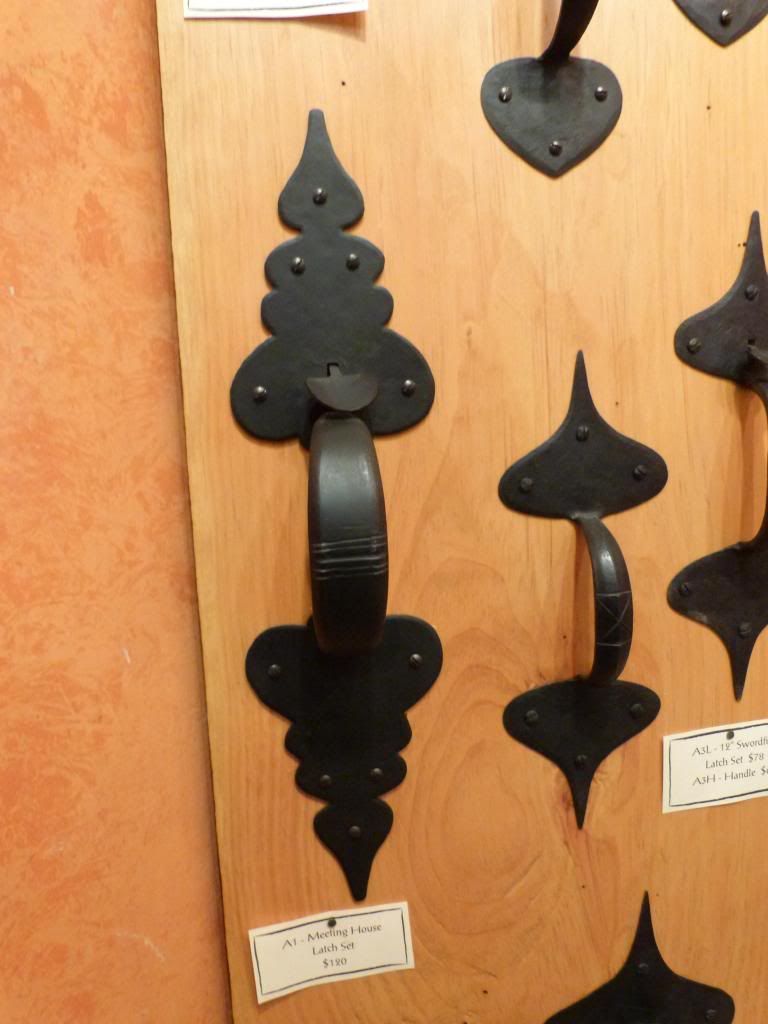One of the exhibitors at the recent Greater Philadelphia Historic Home Show was approaching preservation from a unique perspective – “mass” production.
When most of us think of traditional wrought irons handcrafted by blacksmiths, we think of custom orders. But Fagan’s Forge is forging a new path with handcrafted wrought irons. They sell stock items only, no custom orders. How do they do that? They place orders with traditional blacksmiths across the country for quantities of items that they work on in between their custom orders and then Fagan’s Forge carries that stock.
But don’t let “mass” and “stock” scare you away – Fagan’s Forge is reproducing patterns that are literally hundreds of years old and date as far back as the 1600’s. Nancy McMerriman is the second generation owner of the Forge, her father founded the business, and her knowledge of the history of wrought iron latches, handles, and hinges, along with her attention to detail, results in products that are authentic period pieces.
Below is the information from Fagan’s Forge’s website, you can browse their online catalog here.
A History of Wrought Iron from Fagan’s Forge
WROUGHT IRON THROUGH THE AGES
In the earliest days iron was thought of as a strange mystery. It was such a wonderful material, so hard, so strong, beyond the imagination of early man to take for granted. They were so impressed that they envisioned gods to be responsible for the existence of this wonder metal. The material from which King Arthur’s Excalibur was fashioned. the Norse god, Odin was thought to assist a gifted smith with his very fine work, and in the Christian era, St. Clement was the patron saint of blacksmiths.
The black smith, the anvil smiter, was thought to be the most important craftsman of his time. He made most of the tools used by other craftsmen to ply their trade. Without the blacksmith, the other tradesmen activity would grind to a halt.
The great Roman historian Pliny, speaks at length about iron, the wondrous metal that did great work turning over the earth at plow time and slaughtering the enemy in time of war. Wrought iron is an enduring metal, in places where it has been left to perform its first intended work, “if it could speak” would tell us tales from the birth of this now mighty land. It would tell us of times of doubt, times when our might was not so great that we could think that this might was right.
THE MATERIAL – WROUGHT IRON

The making of wrought iron became established in Europe about 500 B.C. The wrought iron was much harder than bronze, and the iron ores were more widely distributed. The other ingredient, charcoal, was also readily available. Wroughtiron, though not as hard as steel, did have a quality superior to steel in that it resisted rusting due to its silica, or glass, content. The silica arranged itself in thin layers in the wrought iron and restricted the formation of rust.
The eastern coast of North America was found to have considerable deposits of iron ore and the ample forest cover provided an excellent supply of charcoal to fuel the blast furnaces of the day.
The colonies exported a good amount of iron bar to England before the Revolution. During the Revolution bog iron from the New Jersey pine barrens supplied iron to cast cannons for our revolutionary forces.
After the Revolution iron production dropped off until the country reorganized. After that point iron, and then steel production grew at a phenomenal rate to support the great expansion of new industry and the great expansion west.
Wrought iron with its ductile rust resistant qualities is just about nonexistent today. We use the term “wrought” as an adjective concerning iron not as the very important noun it used to be.
The mild steel we use today to make types of objects from an earlier time may not resist rust to the degree wrought iron did but our improved coatings may help a bit.
A History of Hinges
Large HL Hinges were common for passage doors, room doors and closet doors in the 17th, 18th and even 19th centuries. On taller doors H hinges were occasionally used in the middle along with the HL hinges.
H Hinges were shaped like an H and used on flush mounted doors. Small H hinges (3–4 in/76–100 mm) tend to be used for cabinet hinges, while larger hinges (6–7 in/150–180 mm) are for passage doors or closet doors.
A BIT OF HISTORY

1694 – Those wishing to inspect the house carefully may see in the cellar the foundation arch of hand-made bricks and stone, and an old closet door with hinges attached by hand-made nails. In the attic is another of these HL hinges; the chimney is of bricks made in the town in 1694, originally joined with mud mortar. The floors and most of the roof timbers are the original white pine, and some of the old wooden pins with which they were put together still remain.
1730 – The HAVILAND INN was built in 1730 and is now the village hall. The original windows are intact; the beams are wooden-pegged; hand-hewn shingles cover three-quarters of the structure; several of the doors have Colonial “HL” hinges. Dame Tamar Haviland, a war widow, was here hostess to Washington on several occasions.
1775 – The H and HL hinges came into use in New England in the early and lasted until after the Revolution. These hinges were cut out of heavy sheet iron and were made in factories in England. This type of hinge was superseded by the cast-iron butt, still in use, which was invented in England in 1775, and adopted very generally in the United States at the close of the Revolution. In some old houses that have been restored and in many modern constructions done in the manner of the colonial homes.
1837 – When the colonies belonged to England, they followed English laws for marking silver, but after independence, standards varied. In 1837, Congress passed a law that established 900/1000 as the official standard for coin silver. Most silver objects stamped “coin” were not made from melted coins. THE COLONISTS WERE SO RELIGIOUS THAT THEY PUT HL HINGES ON THEIR DOORS, WHICH STOOD FOR HOLY LORD.
1948 – CLUES: In 1948, author Carl Drepperd wrote that, “Anything in wrought iron, from a four-inch rattail hinge to a complete iron balcony, has a collector waiting somewhere for it. Even the common H and HL hinges have value, while ram’s-horn hinges are on a parity with fine historic china.” What he didn’t say was that all of these, and other wrought iron items were being reproduced; and still are.
1989 – Even the common H and HL hinges have value, while ram’s-horn hinges are on a parity with fine historic china.

About Handles
Bean Handle
The Bean is a delicate handmade iron pull, simple in design and very functional. The most common pull found in early New England homes. A beautiful replica of the early handle, the Bean handle is finished with a rubbed beeswax/linseed oil finish that brings out the beauty of the iron details. For outdoor use, request a painted black finish. Please note that the height of the Bean handle is not the same as the height of the Bean latch, although the proportions are the same. 2-1/2” x 6-1/2”
Spade Handle
The Spade handle is sister to the Spade latch and is perfect for closets, large cupboards or any application where a full latch is not necessary. The Spade is suitable for interior or exterior use, and can be ordered in a boiled beeswax/linseed oiled finish or painted black.. 3” x 10”
About Latches

Bean Latch
In the Suffolk family of latches and handles, the Bean latch is a simple latch design, the most common found in early New England homes. Ours is a beautifully hand made replica of an early latch found in Horsham, Pennsylvania, circa 1755.
Can be ordered with a rubbed oil finish for interior, or painted black finish for exterior use. 2-1/2” x 8”
Spade Latch
Another Suffolk variety, our Spade Latch is a beautifully hand-crafted piece that will grace any handsome paneled or plank door. The history of this latch extends all along the eastern shoreline, and its ancestors can still be found in many antique homes in New England.
The Spade is suitable for interior or exterior use, and can be ordered in a beeswax boiled Linseed oiled finish or painted black.. 3” x 10”
Meeting House Latch
This handsome latch is quite an eye-catcher. Reproduced from a latch found on the front of a 1780 Connecticut meeting house, this large latch is a beautiful representation of colonial craftsmanship.
The Meeting House latch would grace the front entryway of any restoration or reproduction home. 4-1/2” x 18-1/2”
Mission Latch
Another Suffolk Latch variety, the Mission latch is a slightly different design than was commonly seen in early colonial homes. Ours is similar to a door in the Wayside Inn, Sudbury Massachusetts, circa 1683.
This beautiful latch, with its beveled edges and detailed hammered finish, would be a handsome addition to a period home or elegant outbuilding. Because of its size, the Mission latch is primarily an exterior latch, so is painted black to withstand the weather. 3-1/2” x 13-1/2”

